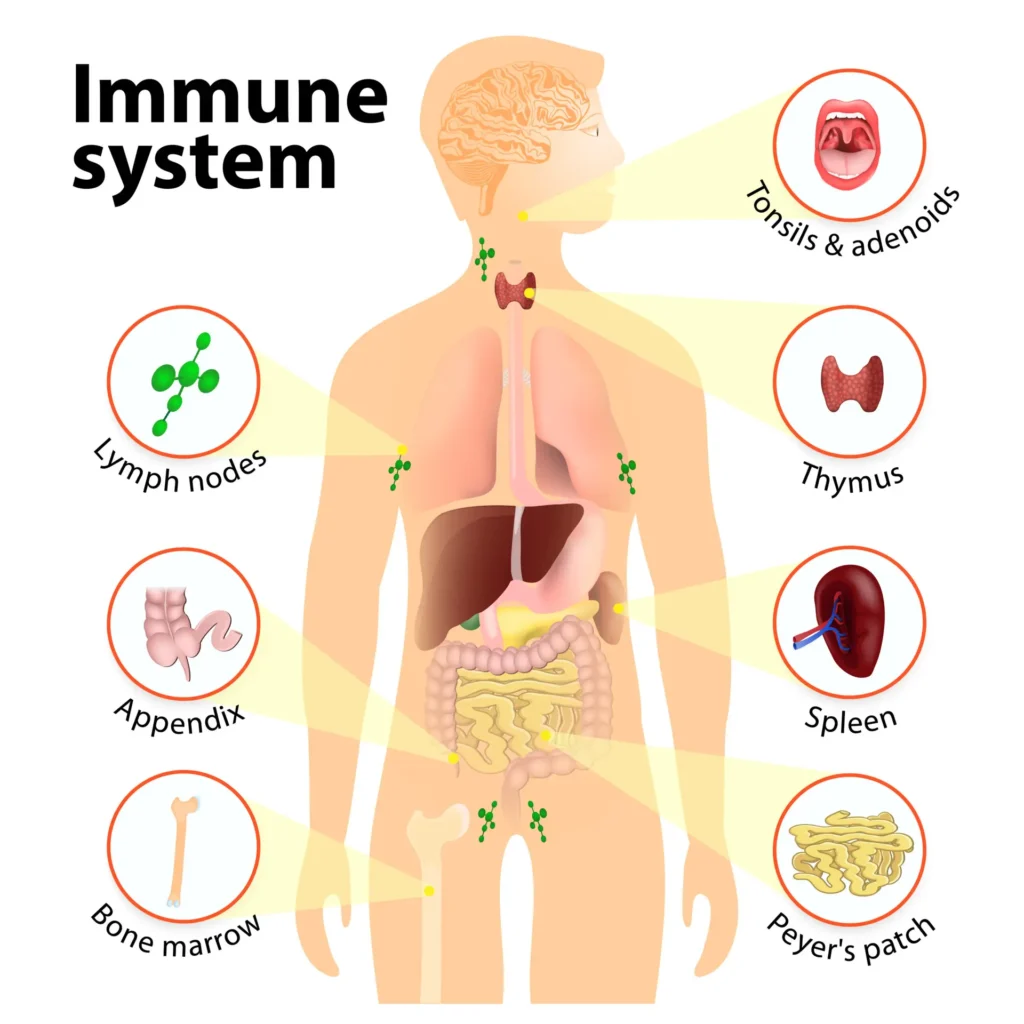The Immune System
The immune system is a complex network of cells, tissues, and organs that work together to protect the body from harmful invaders like bacteria, viruses, fungi, and toxins. Its primary role is to detect and destroy pathogens (disease-causing organisms) while distinguishing them from the body’s own healthy cells. A well-functioning immune system is vital for maintaining health and preventing infections, diseases, and other health issues.
Structure of the Immune System
The immune system is made up of several key components, each playing a specific role in defending the body. These include:
- White Blood Cells (Leukocytes): White blood cells are the soldiers of the immune system. There are several types of white blood cells, including:
- Neutrophils: The first responders that attack bacteria and fungi.
- Lymphocytes: These include B cells, T cells, and natural killer (NK) cells that are crucial for adaptive immunity.
- Macrophages: These cells engulf and destroy pathogens and dead cells.
- Dendritic Cells: These act as messengers between the innate and adaptive immune systems.
- Bone Marrow: The bone marrow produces new blood cells, including white blood cells. This is where B cells mature before entering the bloodstream to help fight infections.
- Thymus: The thymus is where T cells mature. These cells are critical in recognizing and attacking infected cells or coordinating the immune response.
- Lymphatic System: This system includes lymph nodes, lymphatic vessels, and lymph fluid, which help transport white blood cells and filter out harmful pathogens.
- Spleen: The spleen filters the blood, removing old or damaged red blood cells and pathogens. It also stores white blood cells that can be deployed to fight infections.
- Mucous Membranes: Found in areas like the nose, mouth, and lungs, mucous membranes trap pathogens and prevent them from entering the body.
The Two Arms of the Immune System
The immune system has two major components: innate immunity and adaptive immunity. Both work together to keep the body protected from harmful invaders.
1. Innate Immunity
Innate immunity is the body’s first line of defense and provides a rapid, nonspecific response to invading pathogens. This part of the immune system is always active and ready to fight infections. Some of the key features of innate immunity include:
- Physical Barriers: The skin and mucous membranes are the body’s first defense against pathogens.
- Inflammation: When an infection occurs, the immune system triggers inflammation to isolate and attack the pathogen.
- Phagocytosis: Cells like neutrophils and macrophages engulf and destroy pathogens in a process called phagocytosis.
- Natural Killer Cells: These cells detect and destroy virus-infected or cancerous cells.
Although the innate immune system responds quickly, it does not remember pathogens for future encounters.
2. Adaptive Immunity
Adaptive immunity is more specific and targeted. It involves a slower response than innate immunity, but it has the ability to remember past infections, leading to faster and more effective responses upon subsequent encounters with the same pathogen. This is known as immunological memory.
- B Cells: These cells produce antibodies that neutralize pathogens or mark them for destruction by other immune cells.
- T Cells: There are two main types of T cells:
- Helper T Cells: These cells help activate B cells and other immune cells.
- Cytotoxic T Cells: These cells directly attack and destroy infected cells.
Adaptive immunity is the basis for vaccination, which exposes the immune system to a harmless version of a pathogen, allowing it to develop memory without causing illness.
Fighting Infection
When the body detects a pathogen, the immune system launches a series of responses to neutralize and eliminate the invader. The steps include:
- Detection: Specialized cells recognize foreign invaders using antigens, which are molecules on the surface of pathogens.
- Activation: Once detected, immune cells are activated to fight the infection. This can include the release of cytokines, signaling molecules that help coordinate the immune response.
- Attack: White blood cells, antibodies, and other components work together to destroy the pathogen.
- Memory: After the infection is cleared, memory cells remain in the body to respond more quickly if the pathogen returns. This is why we often gain immunity to diseases like chickenpox after being infected once.
Disorders
While the immune system is essential for protecting the body, it can sometimes malfunction, leading to various disorders:
- Autoimmune Diseases: In autoimmune diseases, the immune system mistakenly attacks healthy cells. Examples include rheumatoid arthritis, lupus, and type 1 diabetes.
- Immunodeficiency: Conditions like HIV/AIDS result in a weakened immune system, leaving the body vulnerable to infections. Primary immunodeficiency diseases are genetic conditions where parts of the immune system are missing or nonfunctional.
- Allergies: An allergic reaction occurs when the immune system overreacts to harmless substances, such as pollen, food, or pet dander.
- Cancer: Cancers such as leukemia and lymphoma originate in immune cells and affect the body’s ability to fight infections.
Supporting Your Immune System
Maintaining a healthy immune system is essential for overall well-being.
- Healthy Diet: Eating a balanced diet rich in fruits, vegetables, and whole grains provides the nutrients needed to support immune function.
- Exercise: Regular physical activity can improve circulation and promote immune health.
- Sleep: Adequate sleep is essential for allowing the body to recover and maintain a strong immune system.
- Vaccination: Vaccines help train the immune system to recognize and fight specific pathogens, providing immunity without the need for an infection.
Summary
The immune system is a complex network of cells, tissues, and organs that protects the body from harmful invaders like bacteria, viruses, and toxins. It consists of key components, such as white blood cells, bone marrow, the thymus, and the lymphatic system, each playing a crucial role in defending the body. The immune system is divided into two parts: innate immunity, which provides a rapid, nonspecific defense, and adaptive immunity, which targets specific invaders and remembers them for future encounters.
